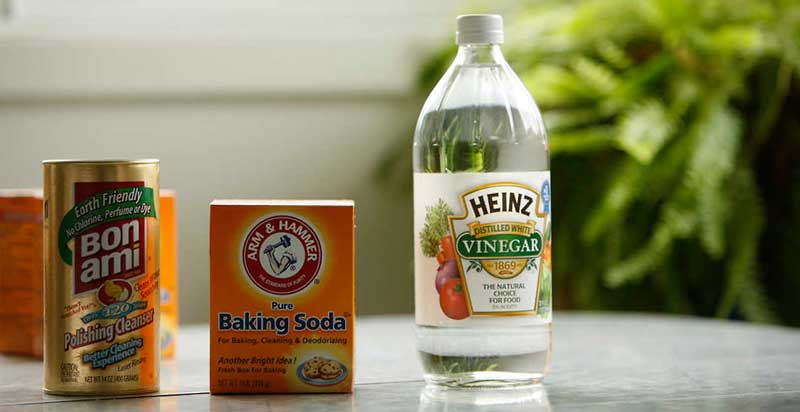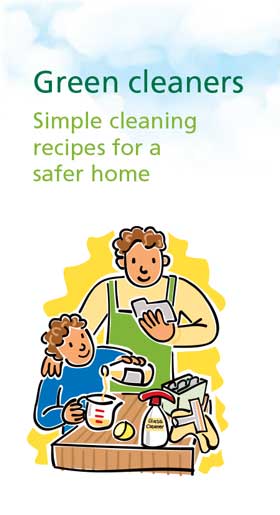Update: 21 December 2024
Non-toxic Cleaning
A clean home environment is important for good health, but most commercial cleaning products are highly toxic. Our grandparents perfected many non-toxic cleaning strategies using common household products such as vinegar and baking soda. Simple, non-toxic cleaning solutions work better, are less expensive, and do not ruin the environment or make you sick.

To enjoy a clean, safe non-toxic home, all you need are a few common ingredients.
Healthy Cleaning Ingredients
You can tackle almost any cleaning project easily with just a few common ingredients you might already have on hand. The following inexpensive household ingredients can be used alone, or to make non-toxic homemade cleaning recipes that really work.

Simple non-toxic recipes and tips to help you enjoy a cleaner home. Protect your family and the environment. ![]()
Non-toxic Cleaning (key ingredients and products)
- Baking Soda (sodium bicarbonate)
-
Baking soda absorbs odors and is a mild abrasive. Baking soda helps regulate or balance pH — neither too acidic nor too alkaline. When baking soda comes in contact with an acidic or an alkaline substance, its natural effect is to neutralize that pH. Baking soda has the ability to retard further changes in the pH balance also (buffer). This dual capability of neutralizing and buffering allows baking soda to neutralize acidic odors (e.g., refrigerator) as well as maintain neutral pH (in your laundry water it helps boost detergent's cleaning power). Excellent for a number of cleaning and deodorizing tasks.
- Vinegar
-
Look for organic vinegar if you want to be safe. Even though vinegar is at the top of most non-toxic cleaning lists, beware! According to the FDA's website, petroleum can be utilized to begin the process of vinegar making. And the FDA doesn't require manufacturers to label the vinegar as being derived from a petroleum starter.
"Presently, we authorize the manufacture of vinegar from ethyl alcohol synthesized from natural gas or petroleum derivatives. FDA CPG Sec. 555.100; Use of Synthetic Alcohol in Foods
Heinz® says their vinegar is derived from select sun-ripened grain. Heinz does use corn for their white vinegar, which brings up concerns of GMOs (that contain glysophate).
Vinegar has been produced commercially for about 2,500 years. It is effective for removing soap scum, grease and mineral deposits and acts as a deodorizer. Cetic acid is the active ingredient in the bottle of white vinegar that you buy at the grocery store, found in concentrations of 3% or 5%.
- Washing Soda (sodium carbonate)
-
Washing soda removes grease and can be used for many tough cleaning jobs. One powerful use is making you own "oxygen" cleaner.
Homemade Oxy-Cleaner Recipe
CAUTION: Although non-toxic, this can damage wood finishes.
- 1 part - Arm & Hammer Super Washing Soda
- 1 part - Hydrogen peroxide
- 2 parts - Very hot water (so the washing soda dissolves)
- Hydrogen Peroxide (H2O2)
- Hydrogen peroxide is a disinfectant. One use is to put in a spray bottle and spray on your cutting boards.
- Vegetable Oil-based Soap
- Vegetable oil-based liquid soap (eg., castile soap).
- Bon Ami
-
Bon Ami is a non-toxic, gentle but effective no-scratch cleanser. Ingredients are biodegradable and hypoallergenic. There are 2 Bon Ami powdered cleaning products, Original 1886 Formula and Bon Ami Cleanser:

1. Bon Ami Original 1886 Formula Cleaning Powder (12 oz. red can) is recommended for windows, mirrors, vintage auto windshields, patio and shower doors, other non-decorative glass surfaces, and many other household hard surface cleaning needs. While both of the Bon Ami products contain only softer, mild abrasives, the tallow soap in the 1886 formula coats the feldspar, which creates less friction between the surface you are cleaning and the feldspar. The tallow in the product will create suds and a tactile soap "layer." The residual tallow also helps prevent fogging.
How to clean glass surfaces (windows, mirrors, shower doors, etc.) with Bon Ami Original 1886 Formula
- Do an initial cleaning with vinegar (put in a spray bottle),
- Mix Original formula 1886 Bon Ami Cleaning Powder with a little warm water to form a liquid paste,
- Apply to glass surface with a clean damp cloth, soft sponge, or non-scratch scrub pad
- Gently rub in a circular motion, a white film will form. You'll see if you get everything, surface and corners,
- Buff dry film away with a very clean lint-free cloth. A dedicated buff cloth is important for best results.

2. Bon Ami Cleanser (14/21 oz. gold can) is ideal in hard water areas and will provide that "squeaky clean" experience most people are familiar with. Bon Ami Cleanser is a safe and effective cleaner for many hard surfaces (most sinks, tubs, tile, pots, pans, etc.); however, the biodegradable detergent does not reduce friction as well as the Bon Ami Original 1886 Formula with tallow soap, so we do NOT recommend Bon Ami Cleanser for glass, mirrors, highly polished, decorative, or painted surfaces.
- Borax (Sodium Tetraborate)
-
Borax is used in various household laundry and cleaning products, including the "20 Mule Team Borax" laundry booster and "Boraxo" powdered hand soap. Borax is an effective natural cleaner and a safer alternative to many conventional cleaners. It also is a natural pesticide. We are not aware of conclusive scientific evidence that borax is either safe or harmful to humans. However, it is harmful when ingested or rubbed in the eyes.
- Boric Acid Technical Facts
- Is Borax Harmful To Dogs?
- Get Rid of Ants - Naturally
- Essential Oils (nice, optional)
- Essential oils are distilled from leaves, twigs, seeds, flowers and roots and wood. Examples include, mint, eucalyptus, lavender, tea tree oil, citrus (e.g., soak orange peels in vinegar for a few days, then use the vinegar as a citrus cleaner), and others oils. When added to your homemade cleaning solutions, they deodorize and add scent.
Toxic Chemical Cleaners
The Environmental Working Group (EWG) website has an interesting Guide to Healthy Cleaning. EWG reviews and rates more than 2,000 common household cleaning products based on the safety of their ingredients and information they disclose about contents. EWG researchers discovered that 53 percent of cleaning products contain ingredients known to harm health. Over half! Some of the toxins they found in common commercial cleaning products include formaldehyde, 1,4-dioxane, chloroform, quaternary ammonium compounds like benzalkonium chloride, and more. Many are known to cause cancer and other illnesses.

In a veiled effort to protect cleaning product "secret formulas," some companies don't bother to list any ingredients, while others use vague, evasive or incomprehensible terminology. In fact, less than 10% percent of cleaning products disclose their ingredients. Thanks to corporate lobbiests, ingredient labeling for cleaning products is not a federal requirement. Unfortunately for us, many of the chemicals used in these cleaning products are toxic and linked to cancer.
‘Natural’ does not mean non-toxic (don't be mislead).
Plant-based ingredients do not use petrochemicals, but some plant-derived substances cause allergic reactions and may have other negative health impacts. And some of the so-called natural chemicals used in green products have not been thoroughly tested. The scarcity of solid data about risks associated with cleaning product contents underscores the need for reform of the federal Toxic Substances Control Act of 1976 to require safety testing of chemicals on the market. Also beware of green washing tactics, which use false marketing claims of being environmentally responsible. You do not want to spend money to support a product or service that you think is doing good for the environment, but in reality is doing harm.
Eliminate toxic products from your home.

- Eliminate Antibacterial Products. Antibacterial is another name for antibiotic. Chronic antibiotic exposure is now at pandemic proportions, and is associated with a vast range of health problems. Antibiotic literally means against LIFE. Antibiotic products are directly responsible for the growing threat of drug-resistant super bugs.
- Eliminate Caustic Cleaners. These include oven cleaners and plumbing drain cleaners, etc., all of which are highly toxic. TIP: To unclog a drain, pour baking soda and vinegar or hydrogen peroxide into the drain. Let the mix sit and bubble for a few minutes then flush with a pot of boiling hot water. If that doesn't work, use a manual drain snake or plunger.
- Eliminate Air Fresheners. Most air freshener products contain (top-secret) chemical mixtures, many of which cause cancer.
- Eliminate Most Laundry Products. Detergents, fabric softeners, dryer sheets and other common products you find in the laundry room, especially the ones with fragrance, contain proprietary ingredients that harm health, the environment, and poison the air.
Resources
- How To Develop a Cleaning Routine for Maximum Efficiency
- 10 Essential Cleaning Tools You Need for a Healthy Home
- Homemade and Natural Cleaning Products By Sarah Aguirre
- How to Really Clean Glass Tricks-of-the-trade for spotless, streak free glass.
- How to Kill Ants without Pesticides
- Vinegar Institute Cleaning tips with vinegar
- Bon Ami (excellent cleaning powder, 150 year old recipe)
- Stain Solutions University of Illinois Extension
- The International Institute for Bau-biologie® and Ecology
- Green Cleaning
- Baking Soda, Peroxide, Vinegar...WOW! Natural, non-toxic, all-purpose miracle cleaner
- Naturally Clean Seventh Generation Guide to Safe & Healthy, Non-Toxic Cleaning
- The Organically Clean Home 150 Everyday Organic Cleaning Products You Can Make Yourself
- Prescriptions for A Healthy House
- Non-Toxic "green" information and products (lots of info)
- National Library of Medicine (NLM) Household Products Database What's under your kitchen sink, in your garage, in your bathroom, and on the shelves in your laundry room? Learn more about what's in these products, about potential health effects, and about safety and handling.
- Healthy Homes U.S. Centers for Disease Control and Prevention (CDC)
- EWG's Guide to Healthy Cleaning